Blog: How to Leverage Amazon Pay Per Click to Get Better Rankings and More Data
How to Leverage Amazon Pay Per Click to Get Better Rankings and More Data
Amazon PPC is often an underused tool that can help you to sell more products online. But did you know that it can help you to improve organic rankings for your products as well as increase your breadth of data?
Here at Jungle Scout we love nothing more than to support the growing Amazon seller community in being more successful and selling more products. So we’re going to take a look at the reasons running PPC campaigns may be the missing ingredient to your Amazon recipe.
We’re going to explore:
- Why you should consider Amazon PPC as part of your strategy
- How it can improve organic product listings (which also improves conversions)
- Using Amazon PPC to inform your keyword research
- How you can get more data about your target audience
For those of you out there who aren’t big fans of paid advertising, hear us out. There is a strategy to suit every budget and compelling evidence to support why you might want to give PPC a chance to boost your Amazon selling business.
Reasons To Use Amazon PPC
First let’s take a look at why Amazon PPC is so great and where it is useful. Below is Amazon’s brief summary of reasons to explore using their pay-per-click option:

But don’t just take Jeff Bezos word for it, we have some reasons of our own for you to consider.
Amazon PPC Is Easy To Manage
Especially if you have used Google AdWords or Bing Ads in the past, you might be pleasantly surprised at how much easier Amazon PPC is to set up and manage.
A Large Audience Ready To Buy
Amazon is a place where people go to buy stuff. They’re often not at the top of the marketing funnel, doing some early searches in Google or Bing. They’re much more likely to have an idea about something they need or be ready to purchase, and that’s why you need to be there with your perfect product ready for them to buy.
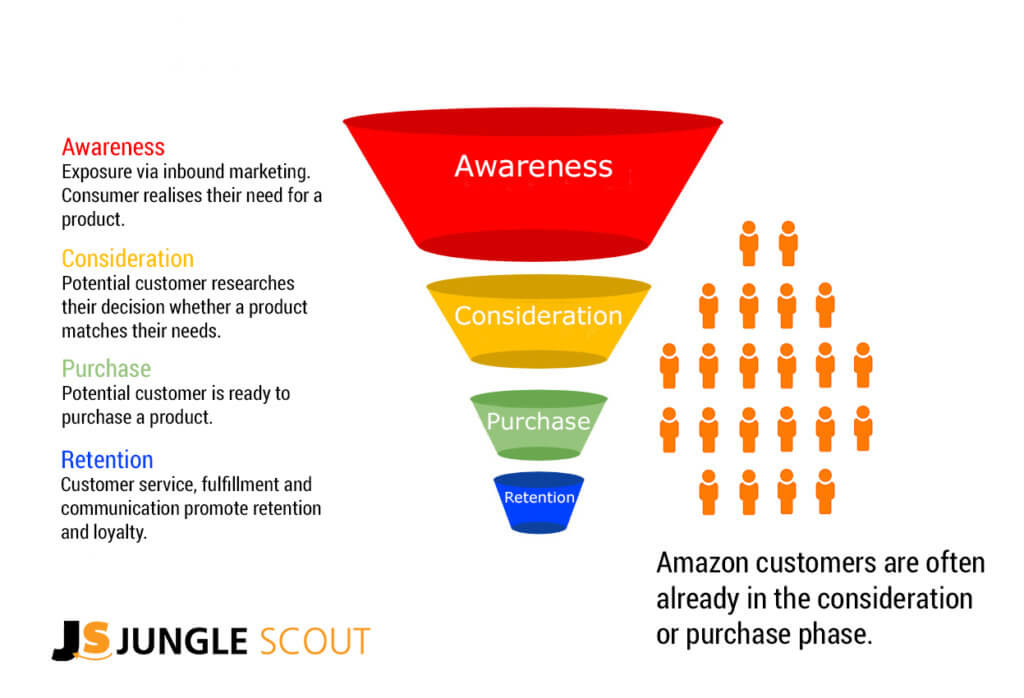
This means that you can get a healthy amount of impressions and more importantly, good return on investment. That is, providing you set up a strong campaign and are able to be flexible and reactive with your campaign management (we’ll get to that part soon).
As an Amazon seller you may be worried about marketing your products outside of the Amazon platform or driving external traffic. But in reality, there is such a huge audience to target within Amazon already, which is a great way to build awareness and exposure.
In case you were wondering, here’s an example of where sponsored ads appear in an Amazon search listing, often above and to the right of organic listings:
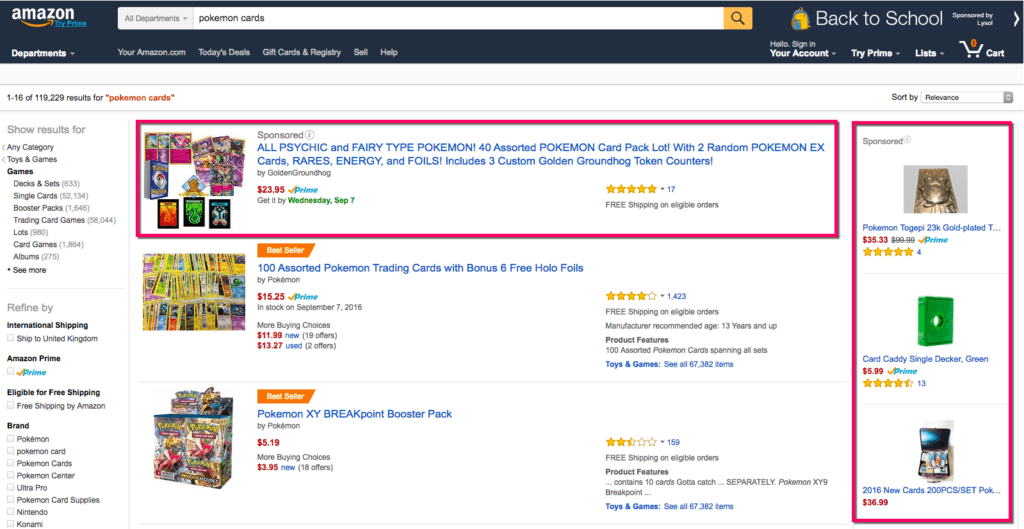
Sales, Results & ROI
Here’s an example of some positive stats from some campaigns we are running at Jungle Scout:
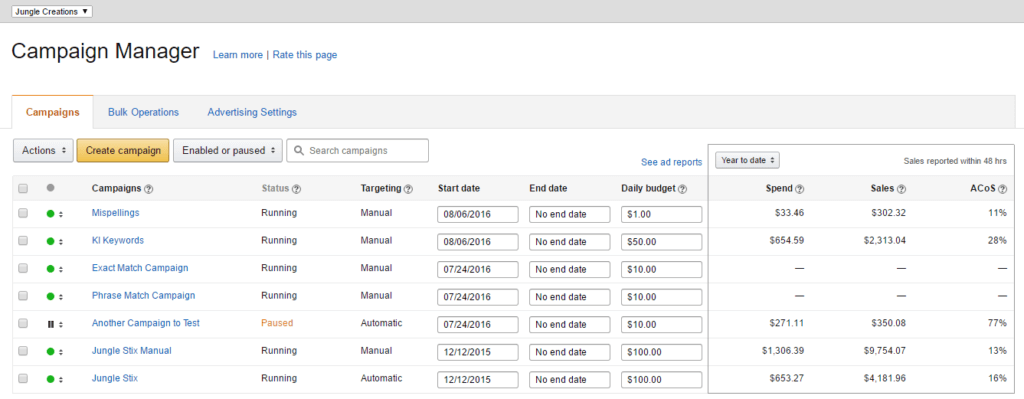
You can see some favourable spend and sales figures, alongside ACoS – ‘Average Cost of Sale’, where we’re spending as little as 13% of the total attributed sales for that campaign.
ACoS is the percent of attributed sales spent on advertising which is calculated by dividing your total spend by attributed sales. You can view ACoS by campaign or at keyword level.
Improve Organic Listings and Sales
ROI might be the most compelling reason to run Amazon PPC campaigns, but it doesn’t stop with the sales you made directly from your ads. As your carefully planned and executed campaigns are going to be building your organic rankings, you are likely to see sales go up in general too.
For example, let’s say you have spent $500 on your PPC campaign and generated 50 sales directly from those ads. But you have also made 150 sales that month organically, which is 100% more than your average monthly sales of that product. If you look at it this way, your campaigns have generated 125 more sales in one month. Even though many of these sales were not directly because of your PPC campaigns, it’s safe to assume that PPC is assisting your improved revenue.
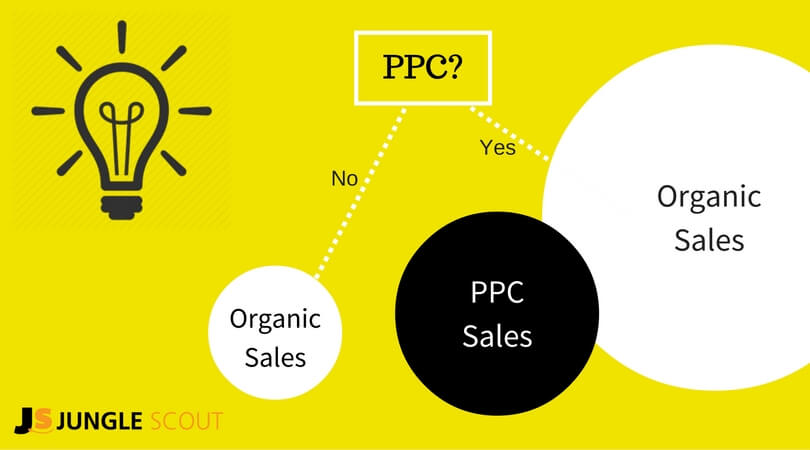
Particularly if you are selling private label products, you can soon start to fulfil your target of selling a specific amount of units per day or more, just by running a few PPC campaigns (we believe a target of 10 is optimum, based on the data we run at Jungle Scout). If you’re selecting products based on sufficient demand with low enough competition for opportunity, Amazon PPC is a surefire way to getting your new product ranking on the first page and selling faster.
Tip: Use the Jungle Scout web app to scout out product ideas that will make you money on Amazon.
Campaigns Are Easy To Set Up
You already did quite a lot of the hard work. There’s no need to spend hours writing ad copy and picking images because your Amazon listing will feed your ad. Take a moment to celebrate how much time that will save you and we’ll move on to some strategies to boost your sales and drive your data. ?
Tip: Read Greg’s in-depth blog post that walks you through setting up your first Amazon PPC campaign.
Amazon PPC Tactics To Boost Revenue and Generate Data
Hopefully by now you have an idea of why Amazon PPC is going to be beneficial to you. Let’s move on and explore some of the methods we use at Jungle Scout to improve sales and conduct valuable keyword research.
Picking Products To Advertise
First of all you need to pick out the products that you want to advertise. Whether you are just starting out or selling competitively, this is an important consideration. If you’re new to Amazon PPC you might want to test it out with just a few products first.
There’s many who would argue that you shouldn’t advertise until you have 5 or 10 reviews on your product, which is definitely the case if you’re being cautious and want to see fast results.
Whilst reviews are definitely a huge driving factor for gaining more sales, that doesn’t mean you can’t utilise Amazon PPC with a product that has little or no reviews yet to get the ball rolling. You just need to be aware of the risks in doing so and be prepared to spend a little more to make progress.
Use Your Product Listing & Google Keyword Planner
One of the best ways to build your keywords at the beginning is to use your own product listing, or even better, a competitor product listing, and put this into Google’s Keyword Planner using the landing page option:
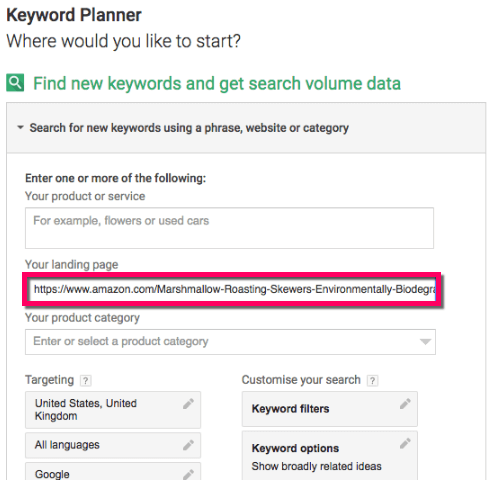
Once you have done this and selected your targeting options, hit enter and out will come your keyword research for that particular listing along with monthly search data:
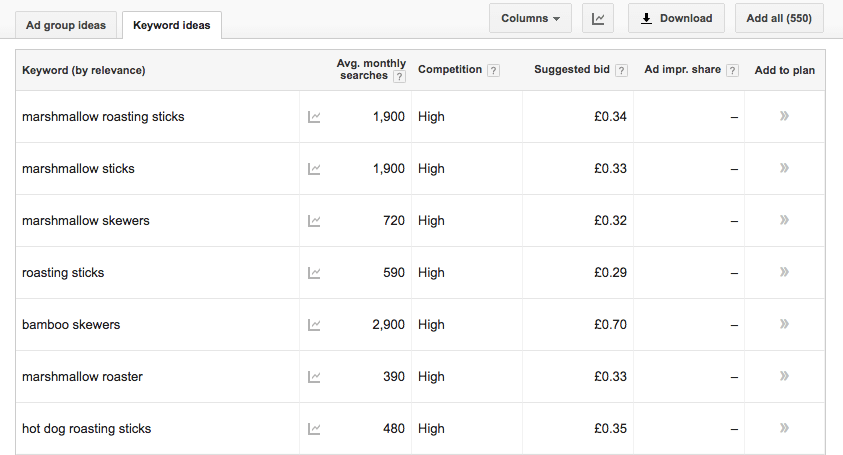
Don’t worry about spending too long on your keyword research before setting up your campaign. You can and should build on that later. If you do have the time and inclination to start with a manual campaign, you’ll need a starting point with a list of keywords you want to bid on.
Use Auto Campaigns
Alternatively, Amazon has a very useful option when setting up a campaign because you can use ‘Automatic Targeting’. Essentially this is based on your product listing, which is scraped for keywords.
Providing you have set up a killer product page, this is a time saving option. In fact, auto campaigns can be super beneficial when you’re starting a new campaign for a product. Here's our 3-step process to getting the most out of auto campaigns without wasting budget:
- Run an auto-campaign for up to 7 days with a sensible budget and bids. Bearing in mind that actual sales data can take a few days to hit your Amazon PPC reports.
Tip: Leave at least a 3 day delay for your sales data to determine results.
- After this period has elapsed, you can download a list of all the search terms people have used to find and click on your ads.
- From here you can pause the campaign, pull out your top performing keywords and then create a manual campaign based on these keywords.
We believe the best option is to do both. It pays off to get busy doing your own keyword research and set up a manual campaign, alongside an auto campaign for an intended short period to find useful keywords.
Keep refining your keywords
Once you have got past the first hurdles of setting up your campaigns and getting your first week's worth of keywords, keep on going. Run your keyword reports regularly and add to your campaigns. You can add up to 1000 KWs in a manual campaign and continue to refine them based on performance.
For a completely manual campaign, you will need to spend time looking at your bids frequently. Over time, you will start to see which keywords are performing and which are not. Where you see a keyword getting the best conversion rate, that is, more sales, increase your bids. Where keywords have lots of clicks and low conversions (thus, a high ACoS), reduce your bids or even consider pausing.
Amazon are now introducing an automated bidding feature. It’s too early to comment on how successful this is at setting efficient bids. However, as with all other online paid advertising platforms, it is always a good idea to keep a close and regular view of your campaigns to ensure they’re performing within your goals and expectations. Be pro-active and reactive with your campaign management style and it will pay off!
Split Campaigns By Match Type
You have the choice to set your keywords as broad, exact and phrase match. One method to keep track of performance is to split up your campaigns by match type.
Here’s an overview of how these match types work:
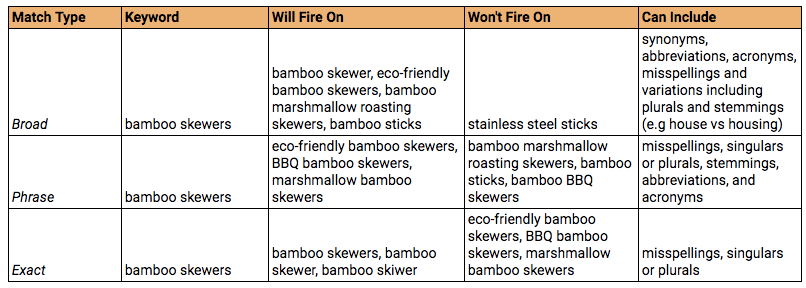
It works in a similar way to other advertising platforms like AdWords and Bing ads. You are also able to add exact and phrase match negative keywords, to prevent your ads from showing when specific search terms are used.
You can probably see by now that each match type narrows down your target audience. Using match types tactically can allow you to open up your ads to a wider audience which is great when mining for keywords. Alternatively, it can allow you to target very specific terms, which is great when you have lots of data and want to improve ROI by honing in on those customers who are ready to buy.
As to be expected, broad and phrase match campaigns often cost more, because they allow for more variance in search terms. However, these keywords are also the best way to get more information about what your potential customers are searching for to find products similar to yours.
This is where you can continuously review your data and iterate the keywords you are targeting and what match types you use for those keywords.
Tip: Add keywords you find in your broad search term reports into phrase or exact match campaigns, which will help to improve ROI over time.
Feed Keyword Research Back Into Product Listings
Hopefully you’re going to start to find new keyword ideas and some long-tail keywords that will help you to improve your PPC campaigns. But don’t forget that this data is extremely useful in understanding what your target audience are searching for.
Make sure you feed this directly back into your organic listings where necessary to keep them optimized for the key terms that you know perform well and resonate with your audience of potential buyers.
Tip: Feed your keyword research back into your product listings and optimize for your organic listings.
Figuring Out How Much To Spend
Make sure you do the math first and be certain that you have a view of how much you’re willing to spend without impacting on your revenue too hard.
For example, if you’re selling a product for $35 and the cost of goods is $10, with FBA and other fees at $15, you have $10 profit to play with. From here you can decide how much you’re willing to spend on PPC ads.
Tip: Remember to account for the cost of goods, FBA fees and any other miscellaneous costs to figure out your true profit per unit.
Test Your Bids
If you’re unsure about what you set your campaign budget and bids as, then one technique you can do is to set it higher to begin with. So if you know you have $10 profit, try setting your maximum bid as that amount. This doesn’t mean you will actually spend that much every time someone clicks your ad. But what it will do is give you an average CPC (cost-per-click). So if you find your average CPC is $3.50, reduce your bid down to $4 to ensure you’re competitive.
Conclusion
As you can tell by now, we really advocate using Amazon PPC as it is a great way to improve sales and rankings, with the added bonus that you will get lots of keyword research and data whilst you are at it.
Here’s our key recommendations:
- Continually monitor your organic listings and overall sales alongside your PPC campaigns, so that you can see what positive effect they are having besides the direct return on investment.
- Ensure you get your dollars worth and leverage your PPC campaigns to mine for keywords, and feed these back into your campaigns and see what sticks. Don’t forget this data is showing you what your potential customers are searching for, so don’t miss opportunities to optimize your organic listings using this information too.
- If you have some margin to play with, you can utilise Amazon PPC when you have a great selling product to give it an extra boost. Conversely if you have a product that is underperforming, PPC can assist you in getting it visible and ranking better organically.
- Remember that you need to dedicate time to your campaigns each week – be reactive and keep improving your strategy.
Over To You
We hope you found this useful, whether you are already running campaigns and found some new tips, or if you’re an Amazon PPC beginner.
It's not a bad thing to have a healthy competitive streak when it comes to selling online. Amazon PPC can certainly help give you that competitive edge.
We’d love to hear about your own successes or tips in the comments!
